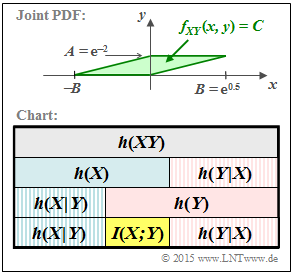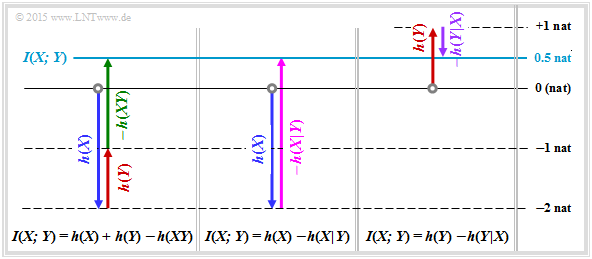Exercise 4.5Z: Again Mutual Information
The graph above shows the joint PDF fXY(x,y) to be considered in this task, which is identical to the "green" constellation in Exercise 4.5.
- In this sketch fXY(x,y) is enlarged by a factor of 3 in y–direction.
- In the definition area highlighted in green, the joint PDF is constant equal to C=1/F, where F indicates the area of the parallelogram.
In Exercise 4.5 the following differential entropies were calculated:
- h(X) = log(A),
- h(Y)=log(B⋅√e),
- h(XY)=log(F)=log(A⋅B).
In this exercise, the parameter values A=e−2 and B=e0.5 are now to be used.
According to the above diagram, the conditional differential entropies h(Y|X) and h(X|Y) should now also be determined and their relation to the mutual information I(X;Y) given.
Hints:
- The exercise belongs to the chapter AWGN channel capacity with continuous input.
- If the results are to be given in "nat", this is achieved with "log" ⇒ "ln".
- If the results are to be given in "bit", this is achieved with "log" ⇒ "log2".
Questions
Solution
- The random variable X is uniformly distributed between 0 and 1/e2=e−2:
- h(X)=ln(e−2)=−2nat_.
- The random variable Y is triangularly distributed between ±e−0.5:
- h(Y)=ln(√e⋅√e)=ln(e)=+1nat_.
- The area of the parallelogram is given by
- F=A⋅B=e−2⋅e0.5=e−1.5.
- Thus, the 2D-PDF in the area highlighted in green has constant height C=1/F=e1.5 and we obtain for the joint entropy:
- h(XY)=ln(F)=ln(e−1.5)=−1.5nat_.
- From this we obtain for the mutual information:
- I(X;Y)=h(X)+h(Y)−h(XY)=−2nat+1nat−(−1.5nat)=0.5nat_.
(2) In general, the relation log2(x)=ln(x)/ln(2) holds. Thus, using the results of subtask (1), we obtain:
- h(X) = −2nat0.693nat/bit=−2.886bit_,
- h(Y) = +1nat0.693nat/bit=+1.443bit_,
- h(XY) = −1.5nat0.693nat/bit=−2.164bit_,
- I(X;Y) = 0.5nat0.693nat/bit=0.721bit_.
- Or also:
- I(X;Y)=−2.886bit+1.443bit+2.164bit=0.721bit.
(3) The mutual information can also be written in the form I(X;Y)=h(Y)−h(Y∣X) :
- h(Y∣X)=h(Y)−I(X;Y)=1nat−0.5nat=0.5nat=0.721bit_.
(4) For the differential inference entropy, it holds correspondingly:
- h(X∣Y)=h(X)−I(X;Y)=−2nat−0.5nat=−2.5nat=−3.607bit_.
- All quantities calculated here are summarized in the graph.
- Arrows pointing up indicate a positive contribution, arrows pointing down indicate a negative contribution.
(5) Correct are the proposed solutions 1 to 3.
Again for clarification:
- For the mutual information I(X;Y)≥0 always holds.
- In the discrete case there is no negative entropy, but in the continuous case there is.

